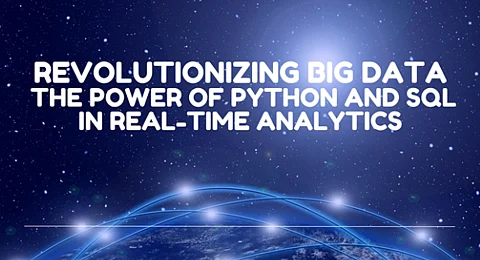

In the ever-expanding landscape of big data, Python and SQL have emerged as fundamental technologies driving innovation in real-time analytics. Based on insights from Amber Chowdhary, delves into how these programming powerhouses are reshaping data processing, enabling organizations to extract insights with unprecedented speed and accuracy.
Python has redefined big data analytics by offering unparalleled support for distributed computing. Its frameworks allow organizations to efficiently handle large datasets across multiple nodes, achieving up to 85% resource utilization in cloud-based environments. The language's parallel processing capabilities significantly reduce computation time, cutting down execution time by 56% compared to traditional methods.
Python’s ability to distribute preprocessing tasks across computing clusters has led to remarkable efficiency improvements. Studies indicate that Python-based frameworks can process 1.2 million records per second while optimizing memory usage. This has proven especially beneficial for fields like scientific research, where massive datasets require meticulous handling without overwhelming computational resources.
The need for interactive and real-time data visualization has propelled Python to the forefront of analytical computing. Scientific institutions have leveraged Python-based visualization tools to process and render complex data, achieving a 67% improvement in memory efficiency. This has enhanced researchers' ability to analyze intricate experimental data, such as climate models and particle physics simulations.
Python’s machine learning frameworks have also revolutionized model training in distributed environments. Benchmarks show that its algorithms process datasets of up to 800GB with 73% faster computation times, accelerating insights in areas like genomic analysis and predictive analytics. By integrating machine learning into big data workflows, organizations are now able to extract actionable intelligence from their data at a previously unimaginable scale.
Big Data analytics fundamentally still relies on SQL more than any other tool, signifying the importance of SQL's query optimization techniques. In a distributed database situation, SQL queries bring a 65% improvement to execution times and optimally facilitate data retrieval and data analysis. Optimized SQL query plans can push databases to up to 85,000 transactions per second, ensuring high operations availability and serviceability, even when concurrent activities are at a peak.
A streamlined technique for big data processing, SQL's data integration capabilities have made the work even easier. SQL-driven frameworks integrate data from disparate sources with an improvement of 63% to integration efficiency. By reducing redundancy and enhancing consistency, SQL offers organizations a reliable access point to structured datasets for decision support.
This has opened new doors for real-time analytics on the Python and SQL duo. Integration of both within a data warehouse architecture results in processing speeds reaching 950,000 records per second and a 43 percent reduction in the latency of data. Such a seamless combination of the flexibility of Python and the structure of SQL in querying has optimized overhead in data processing by an impressive 52 percent in resource utilization. On top of it, these efficiency gains will be massive savings and even competitive advantage for any organization deploying this approach.
The combination of Python with SQL has heralded the beginning of a new era in the analytics of big data. They offer demand-based distributed computing capabilities and bring about achievement in performance-optimized query processing and real-time insights. As more and more companies adopt these technologies, the organizations will observe improvements in analytical accuracy and reduced processing time with improved scalability in developing solutions to continue keeping up with the data explosion.
This potent combination has fundamentally altered how those companies will be able to obtain benefits from such business data assets. Extensive libraries such as pandas, NumPy, and scikit-learn of Python complement the relational algebra of SQL, creating a very solid framework for both exploratory studies and production systems. Cloud-native implementations extend these capabilities to resource elasticity according to the demands of computation.
Banks use this entire stack for fraud detection algorithms that process millions of transactions within a few milliseconds. Healthcare organizations also have adopted this setup of building predictive models for patient outcomes while remaining compliant with HIPAA regulations. They work to optimize available inventories and personalize recommendations for consumers using sophisticated machine learning pipelines.
The value chain is still continuing with innovations like Python UDF directly embedded inside SQL Engines, which are all on their way to offering graph database extensions and specific vector operations that will be relevant to AI applications. Companies that invest in reskilling their workforce in both technologies will acquire significant advantages against their competitors due to improved decision-making and operational efficiencies.
In conclusion, advancements in AI-based analytics, cloud-centric stream processing, and real-time data visualization are bound to reinforce Python and SQL's importance in big-data ecosystems even more. By utilizing these improvements, businesses and research institutions will find transformative insights to facilitate data-driven success. Amber Chowdhary's analysis puts a bright light onto the increasing need for such technologies in shaping the very functionalities/features which will dominate big-data analytics in the near future. This analysis also highlights how these technologies can drive efficiency, accuracy, and real-time decision-making at an unprecedented scale.
